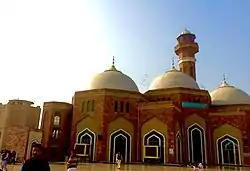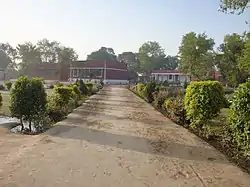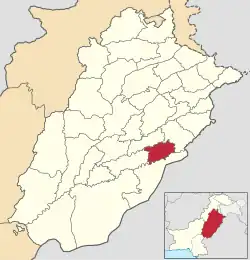Pakpattan District
ضلع پاکپتّن | |
|---|---|
  Top: Mosque at shrine of Fariduddin Ganjshakar Bottom: Tibbi Lal Baig | |
 Location of Pakpattan in Punjab. | |
| Country | |
| Province | |
| Division | Sahiwal |
| Headquarters | Pakpattan |
| Government | |
| • Type | District Administration |
| • Deputy Commissioner | N/A |
| • District Police Officer | N/A |
| • District Health Officer | N/A |
| Area | |
| • Total | 2,724 km2 (1,052 sq mi) |
| Population | |
| • Total | 2,136,170 |
| • Density | 780/km2 (2,000/sq mi) |
| Time zone | PST +5:00 |
| Number of Tehsils | 2 |
| Website | pakpattan |
Pakpattan District (Urdu and Punjabi: ضلع پاکپتّن), is a district of Punjab province in Pakistan, Pakpattan city is the district capital.
Administrative division
The district is divided into two tehsils, which contain a total of 63 Union Councils:[2]
| Tehsils | Union councils |
|---|---|
| Arifwala Tehsil[2] | 30 |
| Pakpattan Tehsil[2] | 33 |
Pakpattan is the city of the great Sufi Saint Baba Farid of Chisti. The original name of Pakpattan was "Ajodhan". It was renamed Pakpattan after it was used for the first time by Baba Fariduddin Ganj Shakar. The word Pakpattan consists of two words "pak" and "pattan" meaning "clean dockland" (Pattan means a dockland or place where ships or boats stop). The city was given this name by Saint Baba Farid. It is said, once Saint Farid having ablution on the bank of the River Sutlej, one local man told the Saint that this water is unclean and this place is dirty then Saint Farid replied to him "no it's clean water and a clean place' in the local language "Pak Pattan'. However, Mughal emperor Akbar first declared its name 'Pakpattan'.
Location
The capital Pakpattan is located about 169 km from Lahore and 205 km from Multan. The district is bounded to the northwest by Sahiwal District, to the north by Okara District, to the southeast by the Sutlej River and Bahawalnagar District, and to the southwest by Vehari District.
History
Pakpattan District was an agricultural region with forests during the Indus Valley civilization. The Vedic period is characterized by Indo-Aryan culture that invaded from Central Asia and settled in Punjab region. The Kambojas, Daradas, Kaikayas, Madras, Pauravas, Yaudheyas, Malavas and Kurus invaded, settled and ruled ancient Punjab region. After overrunning the Achaemenid Empire in 331 BCE, Alexander marched into present-day Punjab region with an army of approximately 50,000. Pakpattan was ruled by Maurya Empire, Indo-Greek kingdom, Kushan Empire, Gupta Empire, White Huns, Kushano-Hephthalites and the Turk and Hindu Shahi kingdoms.
In 997 CE, Sultan Mahmud Ghaznavi, took over the Ghaznavid dynasty empire established by his father, Sultan Sebuktegin. In 1005 A.D., he conquered the Shahis in Kabul in 1005, and followed it by the conquests of Punjab region. The Delhi Sultanate and later Mughal Empire ruled the region. The Punjab region became predominantly Muslim due to missionary Sufi saints whose dargahs dot the landscape of Punjab region.
The main reason of the fame of this city is due to Sufi Baba Farid. Basically he is the man who renamed Ajodhan as Pakpattan. Before his arrival at Pakpattan, there were at least 30,000 Hindus and Sikhs in Pakpattan. He came to Pakpattan on the orders of his Murshad (teacher) Qutbuddin Bakhtiar Kaki for preaching of Islam.
After the decline of the Mughal Empire, the Sikh conquered Pakpattan District. During the period of British rule, Pakpattan district increased in population and importance.
The predominantly Muslim population supported Muslim League and Pakistan Movement. After the independence of Pakistan in 1947, the minority Hindus and Sikhs migrated to India while the Muslim refugees from India settled in the Pakpattan District.
On 6 July 1910, First Rail Link was established to Pakpattan. 345.7 km (213.4 mi) long Lodhran - Kasur section was opened. This section was later dismantled during World War I, reconstructed and opened again between 1923 and 1924. On 15 April 2002, a new Karachi to Lahore express railway via Pakpattan was introduced. The name of the train is Fareed Express.[3]
Demographics
| Year | Pop. | ±% p.a. |
|---|---|---|
| 1951 | 380,678 | — |
| 1961 | 440,091 | +1.46% |
| 1972 | 615,742 | +3.10% |
| 1981 | 843,623 | +3.56% |
| 1998 | 1,286,680 | +2.51% |
| 2017 | 1,824,228 | +1.85% |
| 2023 | 2,136,170 | +2.67% |
| Sources:[4] | ||
At the time of the 2017 census, Pakpattan district had 304,277 households and a population of 1,824,228. Pakpattan had a sex ratio of 965 females per 1000 males and a literacy rate of 52.70% - 62.44% for males and 42.69% for females. 288,992 (15.84%) lived in urban areas. 515,533 (28.26%) were under 10 years of age.[5] In 2023, the district had 344,744 households and a population of 2,136,170.[1]
| Religion | Population (1941)[6]: 62–63 | Percentage (1941) | Population (2017) | Percentage (2017) |
|---|---|---|---|---|
| Islam |
214,966 | 64.46% | 1,818,324 | 99.68% |
| Hinduism |
61,197 | 18.35% | 97 | 0.01% |
| Sikhism |
54,047 | 16.21% | — | — |
| Christianity |
3,234 | 0.97% | 5,741 | 0.31% |
| Ahmadi | — | — | 58 | 0% |
| Others [lower-alpha 3] | 31 | 0.01% | 8 | 0% |
| Total Population | 333,475 | 100% | 1,824,228 | 100% |
At the time of the 2017 census, 96.94% of the population spoke Punjabi and 2.53% Urdu as their first language.
According to the 1998 census, the predominant first language[7] is Punjabi, spoken by 95.9% of the population, followed by Urdu with 3.7%.[8]: 17 Haryanvi, also called Rangari, is spoken among Ranghar, Rajput, while the Meo have their own language which is called Mewati
Agriculture
The Pakpattan District is known for the fertility of its soil and most of the population of Pakpattan district makes a living on agriculture. The main crops are wheat, rice, cotton, maize (corn), sugar cane, etc. The primary fruits and vegetables that are harvested are mango, guava, carrots, potatoes, oranges and okra.
Malka Hans
Malka Hans[2] is the ancient famous town near Pakpattan in Pakpattan District located between Pakpattan and Sahiwal on Sahiwal Road. Malka Hans is located at 30°25′26.4″N 73°16′33.6″E / 30.424000°N 73.276000°E at an altitude of 150 metres (490 ft).[9]
It is famous for being the place of origin for the book of poems on Heer Ranjha folk love story, written by poet Waris Shah.
See also
Notes
- ↑ 1941 figures are for Pakpattan tehsil of the former Montgomery District, which roughly corresponds to present-day Pakpattan district. Historic district borders may not be an exact match in the present-day due to various bifurcations to district borders — which since created new districts — throughout the historic Punjab Province region during the post-independence era that have taken into account population increases.
- ↑ 1941 census: Including Ad-Dharmis
- ↑ Including Jainism, Buddhism, Zoroastrianism, Judaism, or not stated
References
- 1 2 "TABLE 1 : HOUSEHOLDS, POPULATION, HOUSEHOLD SIZE AND ANNUAL GROWTH RATE" (PDF). www.pbscensus.gov.pk. Pakistan Bureau of Statistics. 2023.
- 1 2 3 4 "Tehsils & Unions in the District of Pakpattan". National Reconstruction Bureau, Government of Pakistan website. Archived from the original on 9 February 2012. Retrieved 24 December 2023.
- ↑ Pakistan Railway
- ↑ "Population by administrative units 1951-1998" (PDF). Pakistan Bureau of Statistics.
- 1 2 "District Wise Results / Tables (Census - 2017)". www.pbscensus.gov.pk. Pakistan Bureau of Statistics.
- ↑ "CENSUS OF INDIA, 1941 VOLUME VI PUNJAB PROVINCE". Retrieved 21 July 2022.
- ↑ "Mother tongue": defined as the language of communication between parents and children, and recorded of each individual.
- ↑ 1998 District Census report of Pakpattan. Census publication. Vol. 52. Islamabad: Population Census Organization, Statistics Division, Government of Pakistan. 1999.
- ↑ "Malka Hans, Pakistan Page". Fallingrain.com website. Retrieved 24 December 2023.
